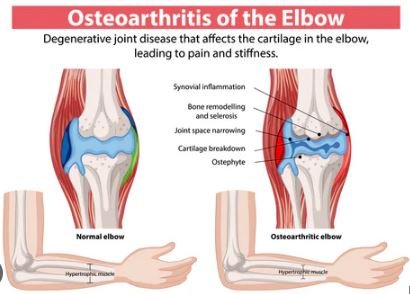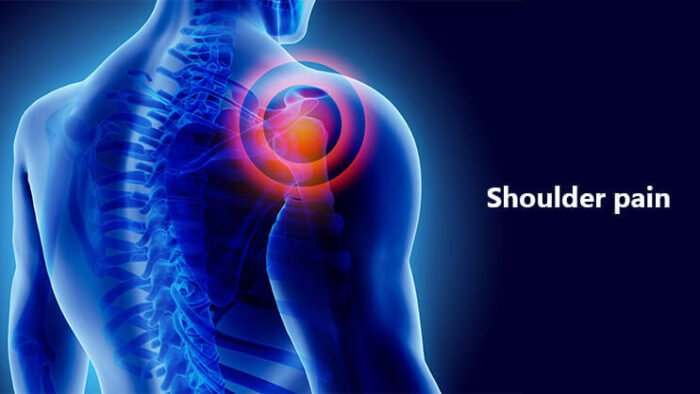Dr. Vivek Mahajan, a renowned expert in orthopedic care, specializes in diagnosing and treating conditions like elbow arthritis, a degenerative joint disorder characterized by the gradual wearing down of cartilage in the elbow joint. This condition leads to pain, stiffness, and restricted movement, significantly affecting daily activities. Understanding the causes, symptoms, and treatment options is crucial for effective management and improved quality of life.
Types of Elbow Arthritis:
- Osteoarthritis: This form of arthritis results from cartilage wear, often due to repetitive motion or trauma to the elbow. It may develop after years of wear and tear or from a past injury like a fracture or dislocation.

2. Rheumatoid Arthritis: An autoimmune disorder that attacks the synovial lining of the joints. It commonly affects both elbows simultaneously and causes pain, swelling, and systemic symptoms.
3. Post-Traumatic Arthritis: Occurs after an injury, causing inflammation in the joint. Unlike osteoarthritis, it develops quickly following trauma.
4. Juvenile Arthritis: This type affects children under 16, causing joint inflammation due to autoimmune issues.
Symptoms of Elbow Arthritis:
- Pain: Persistent or intermittent elbow pain, often worsening with activity.
- Swelling: Noticeable inflammation around the elbow joint.
- Stiffness: Difficulty bending or extending the arm, especially after rest periods.
- Limited Range of Motion: Decreased ability to fully flex or extend the elbow.
- Grinding Sensation: A crunching feeling due to worn cartilage.
- Warmth and Redness: In cases of inflammation, the joint may feel warm or appear red.
- Fatigue: Common in rheumatoid arthritis, with symptoms affecting overall energy levels.
Causes and Risk Factors of Elbow Arthritis:
Several factors that can increase the risk :
- Age: Cartilage naturally deteriorates with age.
- Previous Injuries: Elbow injuries like fractures or dislocations can increase the likelihood of developing arthritis.
- Genetics: A family history of arthritis may contribute to susceptibility.
- Repetitive Use: Occupations or activities involving repetitive elbow motion can lead to joint wear.
- Obesity: Excess weight can stress the joints, contributing to arthritis.
Diagnosis of Elbow Arthritis:
To diagnose elbow arthritis, Dr. Vivek Mahajan recommends:

- Physical Examination: Assessing for joint tenderness, swelling, and reduced mobility.
- Imaging Tests: X-rays or MRIs to visualize cartilage loss and joint damage.
- Blood Tests: In cases of suspected rheumatoid arthritis, blood tests can help identify specific inflammatory markers.
Treatment Options of Elbow Arthritis:
Managing it involves a comprehensive approach, including:

1. Lifestyle Modifications:
- Weight Management: Reducing weight can ease joint strain.
- Exercise: Low-impact activities like swimming can improve joint flexibility.
- Physical Therapy: Stretching and strengthening exercises can relieve stiffness and improve function.
2. Medications:
- Pain Relievers: Over-the-counter painkillers like acetaminophen or NSAIDs help reduce pain and inflammation.
- Corticosteroids: These injections offer temporary relief from severe inflammation.
- DMARDs (Disease-Modifying Antirheumatic Drugs): For rheumatoid arthritis, these drugs can slow disease progression.
3. Surgical Options:
- Arthroscopy: A minimally invasive procedure to remove loose cartilage and bone fragments.
- Joint Replacement: In advanced cases, elbow joint replacement may be necessary to restore function and reduce pain.
Conclusio
This can significantly impact one’s quality of life, but with early diagnosis and appropriate treatment, individuals can manage the condition effectively. Dr. Vivek Mahajan, a leading specialist in joint disorders, emphasizes the importance of a personalized care plan to alleviate symptoms and maintain mobility. If you experience persistent elbow pain or stiffness, consult a healthcare provider for an accurate diagnosis and tailored treatment options.



